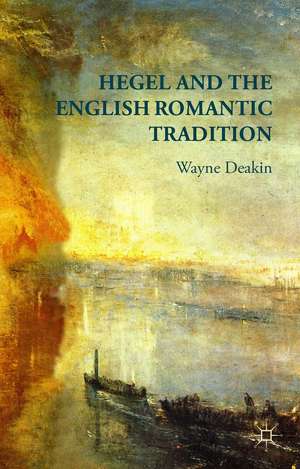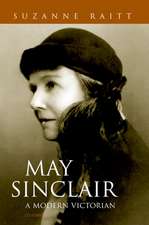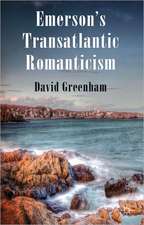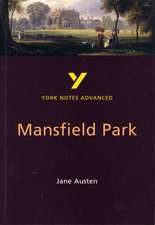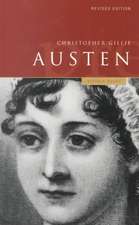Hegel and the English Romantic Tradition
Autor W. Deakinen Limba Engleză Hardback – 30 mar 2015
| Toate formatele și edițiile | Preț | Express |
|---|---|---|
| Paperback (1) | 381.00 lei 6-8 săpt. | |
| Palgrave Macmillan UK – 2015 | 381.00 lei 6-8 săpt. | |
| Hardback (1) | 387.20 lei 6-8 săpt. | |
| Palgrave Macmillan UK – 30 mar 2015 | 387.20 lei 6-8 săpt. |
Preț: 387.20 lei
Nou
Puncte Express: 581
Preț estimativ în valută:
74.09€ • 77.51$ • 61.55£
74.09€ • 77.51$ • 61.55£
Carte tipărită la comandă
Livrare economică 02-16 aprilie
Preluare comenzi: 021 569.72.76
Specificații
ISBN-13: 9781137482174
ISBN-10: 1137482176
Pagini: 198
Ilustrații: IX, 207 p.
Dimensiuni: 140 x 216 x 13 mm
Greutate: 0.4 kg
Ediția:2015
Editura: Palgrave Macmillan UK
Colecția Palgrave Macmillan
Locul publicării:London, United Kingdom
ISBN-10: 1137482176
Pagini: 198
Ilustrații: IX, 207 p.
Dimensiuni: 140 x 216 x 13 mm
Greutate: 0.4 kg
Ediția:2015
Editura: Palgrave Macmillan UK
Colecția Palgrave Macmillan
Locul publicării:London, United Kingdom
Cuprins
Introduction i. A Discrimination of Vriticisms ii. Why 'philosophical romanticism' iii. Romantic Embodiment iv. Chapter Breakdown PART I: HEGELIAN ROMANTICISM AND THE SYMBIOTIC ALTERITY OF AUTONOMY AND RECEPTIVITY 1.1 Introduction 1.2 Hegel's Conception of Recognition in an Aesthetic Light 1.3 Hegel's Response to Romantic Art 1.4 Hegel and Romantic Metaphysics 1.5 Hegel's Aesthetics in the Modern Context PART II: PHILOSOPHY, THEOLOGY AND INTELLECTUAL INTUITION IN COLERIDGE'S POETICS 2.1 Introduction 2.2 Coleridge's Philosophical Dichotomy 2.3 Coleridge's Theological Escape from Aporia 2.4 Symbol and Allegory in Coleridge 2.5 The Deconstruction of Allegory and Symbol in 'Kubla Khan' 2.6 The Antagonists of the Imagination in 'Kubla Khan' 2.7 Coleridge's 'unhappy consciousness' in 'Frost at Midnight' 2.8 The Aporetic Recognition through Joy in 'Dejection' 2.9 Recognitive Breakdown in 'Constancy to an Ideal Object' PART III: WORDSWORTH'S METAPHYSICAL EQUIPOISE 3.1 Introduction 3.2 Wordsworth and Romantic Metaphysics 3.3 Wordsworth's Ladder 3.4 Dialectical Criticism of Wordsworth 3.5 Contingency and Embodiment 3.6 Doubt and Embodiment in 'Lines written a few miles above Tintern Abbey, on revisiting the banks of the Wye during a tour, July 13, 1798.' 3.7 'Home' at Grasmere: Embodiment 3.8 The Unifying Nature of the Wordsworthian Symbol 3.9 Conclusion PART IV: DIALECTICAL COLLAPSE AND POST-ROMANTIC RECOGNITION IN SHELLEY 4.1 Introduction 4.2 Shelley's Quest for the Imagination uponMont Blanc 4.3 Visionary Alienation in 'Alastor' 4.4 Eschatological Projection in 'Adonais' 4.5 Wonder, Transfiguration and Irony in 'The Triumph of Life' PART V: THE CONTINGENT LIMITS OF ROMANTIC MYTH MAKING 5.1 Introduction 5.2 The Romantic Discourse of Wordsworth and Coleridge 5.3 Shelley's Second-order Discourse 5.4 Embodied Scepticism: Frankenstein 5.5 Conclusion
Notă biografică
Dr. Wayne Deakin is Senior Lecturer in English Literature and Language at Chiang Mai University, Thailand. He has published a number of academic articles, including "Acknowledgment and Avoidance in Coleridge and Hölderlin" and is currently writing a book on Hegel, Marx and modern Thai culture.
